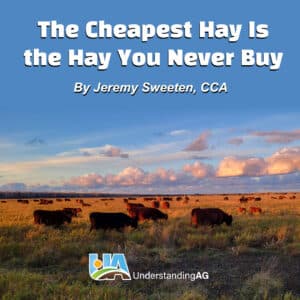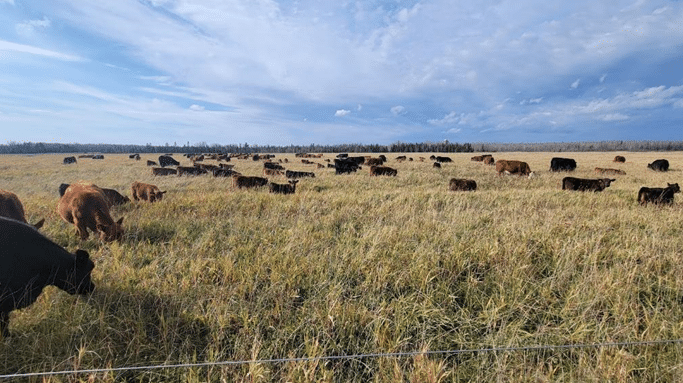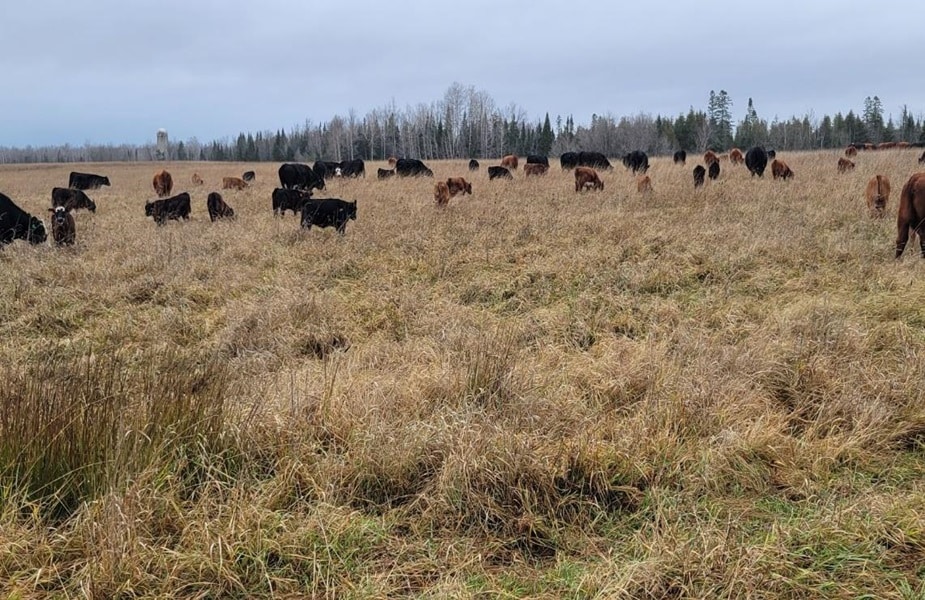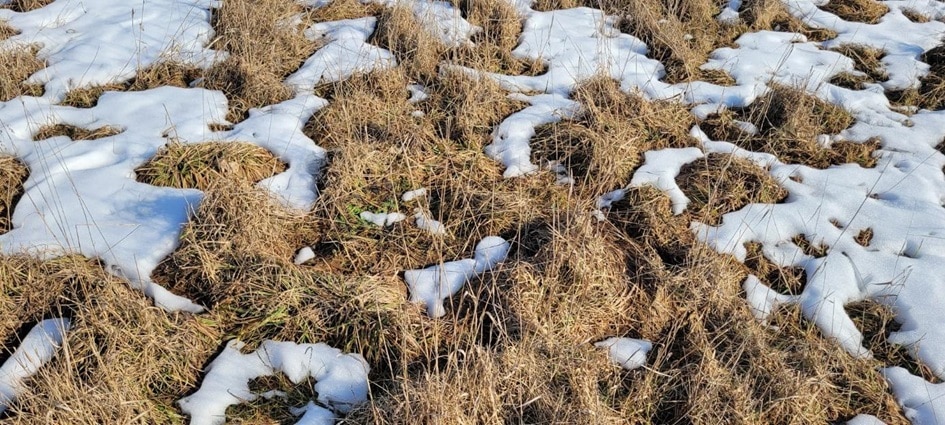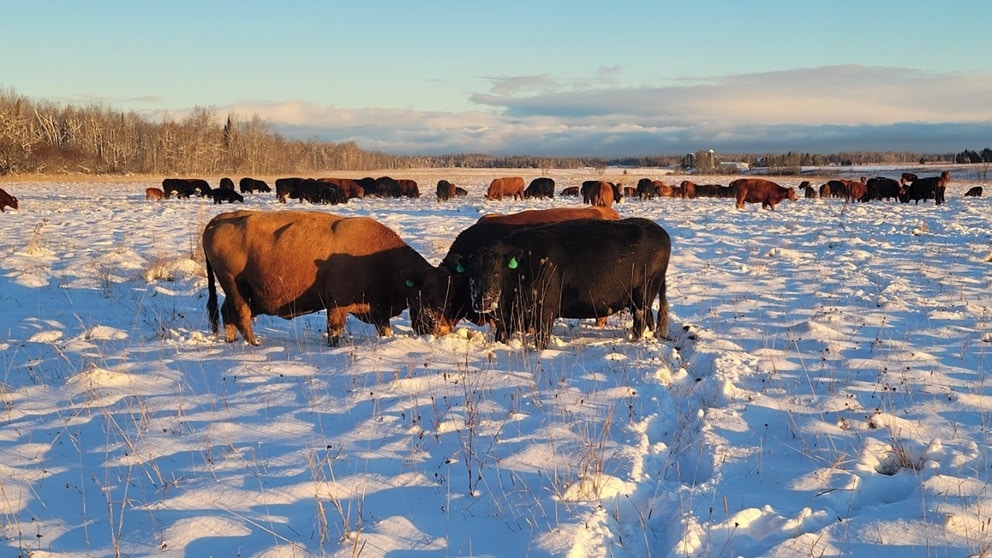The Cheapest Hay Is the Hay You Never Buy
*Additional management considerations for this article were provided by Kent Solberg, Understanding Ag, LLC
Stockpiled Pasture
Regenerative agriculture and adaptive grazing often focus on reducing inputs in an agriculture production system. In the following discussion, I would like to share some thoughts on how to add net profit into a grazing operation, as well as share my own experiences reducing hay inputs with the grass-finished beef herd that roams across our northern Michigan family farm.
Each year provides new opportunities to incorporate more regenerative practices. Over the past several years of following Understanding Ag’s 6-3-4 on our beef farm, we have been developing better soil aggregation through enhanced soil biology, which ultimately results in an increase in the brix content of the plants in the pasture. We have also seen an increase in plant diversity with increased rest periods. Increased plant diversity builds a more robust soil microbial community, and the increase in brix content helps us improve weight gain on marketable animals and help cows carry better body condition. The increased diversity also provides more nutrient-dense pastures for our cattle to graze on. This is a very simplistic explanation for a very complex ecosystem, and for the sake of brevity, I am not going to dive into these subjects much further. Instead, let’s talk about cattle and making money.
On our farm, because of record beef prices, we have culled our cow herd down to the cows that have adapted to our environment, grazing methods, and pasture. The decrease in the overall farm stocking rate has also allowed us to extend pasture rest and stockpile more feed. The stockpiled feed helps us be more profitable because we are not feeding as much hay, and it also provides more opportunities to keep animals out on the landscape gathering their own feed, instead of us supplying it with a tractor. It wasn’t until I had experienced the savings in hay expenses that I realized how powerful a tool stockpiling can be.
Fall grazing stockpiled pasture.
In northern Michigan the general practice is to feed hay from mid-October to mid-May (210 days). At our latitude on the east end of Lake Superior, we average 120-160 inches of snow and can see temperatures as low as -20 to -40F. Annually, hay price and snow depth (amount fed) can vary significantly in our part of the world. It takes 4-6 tons of hay per cow/calf pair to get through the winter in a more traditional system, and in a tough year of cold weather and high snowfall, it may take additional hay per pair to pull them through the winter. Depending on the year, our cost for beef hay will range from $65-$100/T. For easy figuring, over-winter hay for us can range from $300- $650/pair. Over-winter feed costs are often the largest expense for livestock owners, and in many parts of the country where hay is more expensive, it can rob the profit out of cow/calf pair production. Also, in many parts of the country, hay feeding is often unnecessary.
Cow/calf pairs grazing stockpile.
In winter 2023/24, we were able to use stockpiled pasture to decrease the amount of hay we fed our herd (reduced input). We were able to graze 65 pairs and 15 replacement heifers through the summer until early December with grazing starting in early March. It was an easy winter (unexpected), and we were not totally prepared to have as much stockpile on hand as we did. However, the stockpiled pasture gave us 100-110 more days of grazing than previous years. Or said another way, that many days of not feeding hay, starting equipment, and ultimately spending unnecessary money (reduced inputs), resulting in a savings of over 500 bales (~$17,500) in hay alone. This does not consider extra time feeding (labor), fuel, equipment wear, depreciation, etc. Understanding Ag consultant Burke Teichert has stated that one of the most powerful means of improving profitability on a beef operation is reducing overhead, in part by reducing the number of days the herd is grazed0-fed versus feed-fed.
During the harder part of the winter and higher snow depths, we did have to feed hay. However, we took advantage of that to continue to regenerate soils by bale grazing, and as soon as we could move from hay to stockpile, we did it with a smile. As we learn more, we will strive to move away from hay as much as possible. One day beef prices will cycle back down, and we will need to be comfortable operating on thinner margins. The stockpiled pasture made our profit margins wider, making more money with fewer cows. Yes, I said we are making more money with fewer cattle.
Early spring grazing is another advantage to having a stockpile of forage. Throughout the winter, especially in the stockpiled areas, the plants continued to grow, albeit at a slow pace under the snow. When the snow melted off the fields, there was some green growth available amongst the stockpiled forage, and when spring arrived, we observed that the cattle were ready to return to grazing pasture rather than bale grazing. We had 200-plus acres of stockpile from the previous year to graze throughout the green up process. (Remember that this stockpile was only available because we cut the number of cows that we had.) The acreage lasted 65 cows for almost two months of grazing in the spring. Their manure stayed at the pumpkin-pie consistency we wanted to see as an indication of a balanced ration, even through the flush of spring growth. The cattle balanced their own diet between the lush new growth and the high-fiber stockpile. Burke Teichert often says that we should never turn cattle out in the spring because they should already be on pasture.
Stockpiled Pasture – Regeneratively
Stockpiled pasture is a tool that is often overlooked by livestock grazers because of overstocking, which is having more animals on a pasture than it can support without extensive and expensive supplementation. Stockpile is an asset that helps adaptive grazers reduce inputs, continue with livestock impact across the landscape during the dormant season, and ultimately regenerate soil. Stockpile is pasture that is left to grow during the growing season for grazing at a later date, often after the spring flush and can be perennial pasture or intentionally planted diverse cover crops. It is important to be adaptive with the location of the stockpiled pastures each year, so move your paddocks around the farm, changing up what time of year they are grazed and alter the correct amount of rest for each pasture. It is important to note that we should always be grazing with stockpile in front of us.
Context
Stockpiled pasture is always dependent on the context of the producer. A good manager asks: What are the goals? How many animals are they overwintering? What class of livestock are they? Is there enough nutrition in the grass to support the livestock or does it need to be supplemented? Is the farm/ranch stocking rate set at the correct level to allow forage to be stockpiled without over grazing other areas of the farm/ranch?
Minimize Disturbance
Allowing pasture to adequate time for recovery and rest is critical to building soil aggregation. The recovery period is the amount of time a plant needs to fully regrow after being grazed. The rest period is the length of time a plant is not grazed after recovery. Stockpiling pasture provides extended rest periods (after recovery) to encourage new species to germinate and grow. The length of rest and recovery really depends on context such as location, precipitation, plant species, etc. Overgrazing pasture is a negative disturbance just the same as plowing or spraying, so minimizing the negative compounding, cascading effects through adequate rest and recovery is key.
Soil Armor
The beauty of grazing stockpiled forages is that the soil is well armored with well-rested forages. If the snow is not too deep, paddocks can be trampled to incorporate carbon into the soil by using long, rectangular paddocks just as you would during the growing season. It is very important to not overgraze the stockpile and to keep residue on the soil surface even though it is winter, and the plants are generally slow growing or dormant. When there are ample amounts of snow, it is much more challenging to determine how much the animals are grazing, so be very observant.
Living Root in the Soil
In a perennial system, keeping a living root in the soil is somewhat of a given. However, maintaining more roots that are deeper in the soil profile to increase the mycorrhizal fungi association is important for increasing the overall microbial activity in the soil. If plants are overgrazed, then the roots sluff off and die. I try to maintain 50% or less of the plant top growth for grazing, which keeps root loss to a minimum. When you take 60% of the top growth, there can be as much as 50% root die off. Stockpiling from a rest period beyond the essential recovery period allows the plant to grow greater root mass and develop more extensive soil microbial associations as well. The positive compounding, cascading effect of this includes deeper soil aggregation, increased soil pore space and water holding capacity as well as improved nutrient cycling, so allow fields intended for stockpiled forage grazing to have adequate rest during the growing season.
Diversity
Another positive compounding, cascading effect is increasing plant diversity. The longer rest time allows new plants to grow from the seeds in the soil seed bank. The cover of the taller, stockpiled plants moderate temperatures and help conserve moisture for the new seedlings to get established. Ideally, we are trying to mimic the native prairie ecosystems that were not on a fast-grazing rotation, but occasionally had ample rest with high density, short duration animal impact.
Incorporate Livestock
Stockpiling gives the livestock more time out on the land shedding biology, which stimulates the soil microbial community, and with the added benefit of the livestock spreading their own manure and urine. This is a tremendous way to help build the herd of biology underneath the soil surface, capture a greater percentage of the nutrients shed in manure, and increase soil nutrient cycling. Multiple species or classes of livestock can utilize stockpiled pasture in an adaptive system. Don’t limit yourself to just one type of animal. If you are a custom grazer, consider bringing in livestock in the off season and grazing them on stockpile.
Limitations
There are some limitations to the stockpile system that producers need to be aware of. First is a clean, dependable water supply. This can range from a pond with a frost-free nose pump, to well water in frost-free waterer, a temporary continuous flow system, to a good, clean supply of snow. Another limitation to the system is forage quality. At Understanding Ag, we generally see that the higher brix pastures maintain quality and palatability longer into the winter than lower brix pastures which becomes more relevant the further into the winter you go. Snow depth and livestock class can also dictate how far into the winter animals can graze stockpile.
Pastures that are grazed as stockpile during the winter still require ample recovery and rest in the following growing season, which also changes the grazing flow for the following year. Grazing stockpile and not feeding hay is highly dependent on adjusting the farm/ranch stocking rate. This requires a change in mindset and understanding that you are looking for the maximum net profit, not necessarily maximizing the number of animal units during the growing season. Ideally, when changing to a stockpiled grazing system, start off with a few close fields with winter water available. The comfort level versus the amount of risk taken should be evaluated because there will be a learning curve.
Observations
Grazing stockpile is very similar to grazing any other pasture, so pay attention to animal body condition, weight gain, manure texture, and grazing height and biomass removal/trampling. The pasture should be grazed by taking no more than you would during the growing season, and a constant evaluation of the 6-3-4 should be included in the management process. We cannot make substantial gains in our soil and forage resources while violating the principles of soil health and adaptive stewardship. The results of dormant grazing will be no better than the management provided.
Stockpiled forage with green growth underneath the snow.
Snow Depth
Snow depth initially concerned me as a grazer because I wasn’t sure that my cows would be able to harvest enough forage to do well if the snow increased over 12-14” but that was not a valid concern. IF there was good yielding, high brix forage underneath the snow, the cows plow through it without regard for snow depth. IF the forage was lower quality, then they were not apt to dig through it to get a mediocre meal. It is also very important to monitor snow and ice crusting because there is a limit to what a cow can effectively paw through. Regular observation is very important to know when enough is enough and it is time to move over to bale grazing. Our goal is to make our cows work for us, but not to abuse them.
When the Fecal Material Hits the Fan
Part of adaptive management is having a contingency plan (or two or three). We ensure we have enough hay, either purchased or at least located if the winter turns tough. In high-snowfall environments, don’t assume that stockpile will carry you through every year. Plan for the worst but hope for the best, and in more arid, brittle environments, stockpile could well pull you through a drought.
Animal Effects
As discussed earlier, our goal is to push our cattle to be low maintenance and maximize stockpiled feed. The cows that can’t handle the winter grazing will lose condition and not stay in the herd as a bred cow, becoming an open, cull animal. The animals that remain will become more epigenetically adapted to our environment and management methods, and in all likelihood, be more profitable. Our cows work for us, we do not want to work for them.
Conclusion
Using stockpiled pasture can work for many types of livestock, ranging from dry dairy cows, bred dairy heifers, cow/calf pairs, or dry ewes. Following are the key summary points to remember:
• Snow depth, forage quality, animal condition, and producer goals all play a part in the utilization of stockpiled feed.
• Hay is a traditional way of feeding livestock at the cost of net profit.
• Any beef, dairy or sheep operation can benefit from stockpile grazing into the winter months.
• The less snowfall a farm/ranch receives should be utilizing more and more stockpiled feed versus feeding hay.
Grazing through snow. If good feed is there, they will find it.

